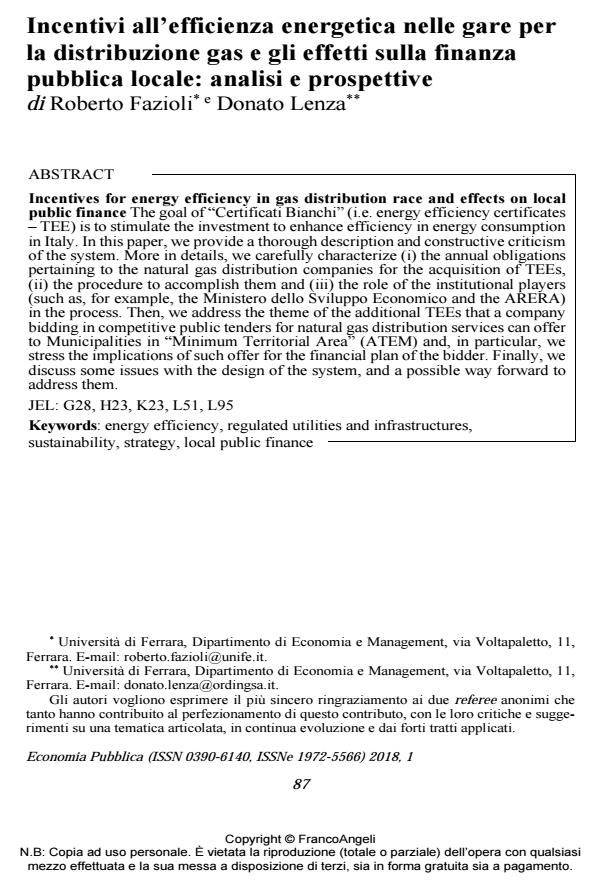Incentivi all’efficienza energetica nelle gare per la distribuzione gas e gli effetti sulla finanza pubblica locale: analisi e prospettive
Titolo Rivista ECONOMIA PUBBLICA
Autori/Curatori Roberto Fazioli, Donato Lenza
Anno di pubblicazione 2018 Fascicolo 2018/1 Lingua Italiano
Numero pagine 36 P. 87-122 Dimensione file 340 KB
DOI 10.3280/EP2018-001004
Il DOI è il codice a barre della proprietà intellettuale: per saperne di più
clicca qui
Qui sotto puoi vedere in anteprima la prima pagina di questo articolo.
Se questo articolo ti interessa, lo puoi acquistare (e scaricare in formato pdf) seguendo le facili indicazioni per acquistare il download credit. Acquista Download Credits per scaricare questo Articolo in formato PDF

FrancoAngeli è membro della Publishers International Linking Association, Inc (PILA)associazione indipendente e non profit per facilitare (attraverso i servizi tecnologici implementati da CrossRef.org) l’accesso degli studiosi ai contenuti digitali nelle pubblicazioni professionali e scientifiche
;
Keywords:Energy efficiency, regulated utilities and infrastructures, sustainability, strategy, local public finance
Jel codes:G28, H23, K23, L51, L95
- Allcott H. (2013). The Welfare Effects of Misperceived product costs: data and calibrations from the automobile market. American Economic Journal: Economic Policy, 5(3): 30-66.
- Allcott H., Mullainathan S., Taubinsky D. (2012). Energy Policy with externalities and internalities, NBER Working Paper, n.17977, January.
- Allcott H., Wozny N. (2012). Gasoline Prices, Fuel Economy and Energy Paradox, NBER working paper, n. 18583, november.
- E.P.R.I. (2009). Assessment of Achievable Potential from Energy Efficiency and Demand Response Programs in the U.S. 2010-2030. Technical Report.
- Gillingham K., Newell R.G., Palmer K. (2009). Energy Efficiency Economics and Policy. Discussion Paper-Resources for the Future, RFF DP 09-13, pp. 1-25.
- Gillingham K., Palmer K. (2014). Bridging the energy efficiency gap: policy insights from economic theory and empirical evidence. Review of Environmental Economics and Policy, 8(1), winter.
- Golove W.H, Eto J.H. (1996). Market barriers to energy efficiency: a critical reappraisal of the rationale for public policies to promote energy efficiency. LBL-38059, Berkeley: Lawrence Berkeley Laboratory, University of California.
- Helfand G., Wolverton A. (2009). Evaluating the consumer response to fuel economy: a review of the literature, National Center for Environmental Economics, Working Paper Series, 09-04.
- Jaffe A.B., Stavins R.N. (1994). The Energy paradox and the diffusion of Conservation Technology. Resource and Energy Economics, may, 16(2): 91-122.
- Jaffe A.B., Stavins R.N. (1994). The Energy-Efficiency Gap. What does it mean?. Energy Policy, 22(10): 804-810, October.
- McKinsey&Co. Report (2013, November). A cura di D. Frankel, S. Heck e H. Tai. Sizing the potential of behavioral energy-efficiency initiatives in the US residential market. McKinsey&Company Edition, Usa.
- McKinsey Sustainability & Resource Productivity (2010, march). Compendium. In: Kiely T. (ed. by). Energy Efficiency. A compelling global resource. McKinsey&Co. Edition.
- Schall D.L., Mohnen A. (2015). Incentives for energy-efficient behavior at the workplace: a natural field experiment on eco-driving in a company fleet. Energy Procedia, 75: 2626-2634.
- Sutherland W.J. (1996). From Individual Behaviour to Population Ecology. Oxford Series in Ecology and Evolution, Oxford University Press.
- Wang S.J., Moriarty P. (2017). Strategies for Household Energy Conservation. Energy Procedia, May, 105: 2996-3002.
- World Bank Group (2009). Energy Strategy Approach Paper – Sustainable Development Network. The World Bank Group, october.
Roberto Fazioli, Donato Lenza, Incentivi all’efficienza energetica nelle gare per la distribuzione gas e gli effetti sulla finanza pubblica locale: analisi e prospettive in "ECONOMIA PUBBLICA " 1/2018, pp 87-122, DOI: 10.3280/EP2018-001004